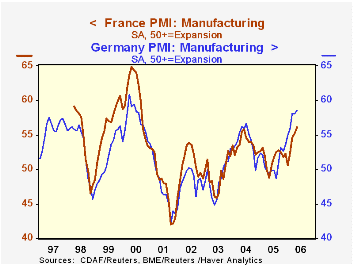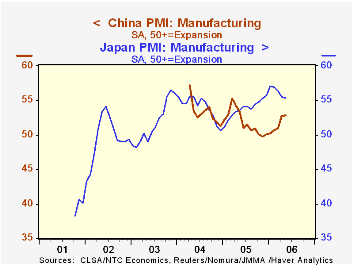 Global| Jun 01 2006
Global| Jun 01 2006PMI Surveys Show Good Manufacturing Growth in Many Countries
Summary
The PMI is a simple survey, asking procurement officers of companies how major measures of their business have behaved in the latest month. Did production go up or down? Did orders go up or down? Did they add employees or reduce their [...]

The PMI is a simple survey, asking procurement officers of companies how major measures of their business have behaved in the latest month. Did production go up or down? Did orders go up or down? Did they add employees or reduce their number? and so on. The results are stated as the number of firms reporting an increase plus half the number reporting no change; anything above 50% indicates an economic expansion. These surveys, coordinated mainly by NTC Economics in London, are becoming available in more and more countries; the table below includes a cross-section from several regions of the world.
May's results for manufacturers, reported on June 1 for nearly all participating countries, generally show a moderately widespread expansion. The margin narrowed in the US, as Tom Moeller highlights here in a separate article, but the indexes were steady or higher in the Euro-Zone, China and South Africa. Among the countries we perused, only Australia showed any notable weakness, falling to 48.93 from 50.27 in April, but this is less severe than it was last autumn. Japan looks to be moving through a slower growth period after peaking in January, but so far the moderation is less than 2 index points.
The European performance is striking. The overall index and the output component both reached their highest levels since August 2000. New orders were off slightly in May, but are hovering in a high range. Even employment has been ratcheting upward since the spring of 2003; this last is a relative movement. Only since December has the employment index been at or above 50%, so until that time "improvement" meant that progressively fewer companies were reporting contractions in the number of workers. Even so, we've so often thought of Europe in the doldrums and these data suggest that's not the case.
In fact, we're fairly impressed with these manufacturing industry performances. Unfortunately, the data for the non-US countries don't have much history, so we can't see how they relate to entire business cycles. However, the Euro-Zone combined index, which began in June 1997, has a remarkable 88% correlation with the year-to-year growth in manufacturing production in the Euro-Zone, with a lead of two months. This suggests more strength to come in Euro-Zone production data. In the face of rising prices of energy, commodities and other inputs, this suggests perhaps more resilience than we'd have envisioned for the European producers.
| PMI Diffusion Indexes | May 2006 | April 2006 |
|---|---|---|
| Euro-Zone | 57.02 | 56.73 |
| Germany | 58.53 | 58.11 |
| France | 56.14 | 55.31 |
| Japan | 55.31 | 55.52 |
| China | 52.83 | 52.72 |
| Australia | 48.93 | 50.27 |
| South Africa | 57.6 | 54.3 |
| Memo: US | 54.4 | 57.3 |
Carol Stone, CBE
AuthorMore in Author Profile »Carol Stone, CBE came to Haver Analytics in 2003 following more than 35 years as a financial market economist at major Wall Street financial institutions, most especially Merrill Lynch and Nomura Securities. She had broad experience in analysis and forecasting of flow-of-funds accounts, the federal budget and Federal Reserve operations. At Nomura Securities, among other duties, she developed various indicator forecasting tools and edited a daily global publication produced in London and New York for readers in Tokyo. At Haver Analytics, Carol was a member of the Research Department, aiding database managers with research and documentation efforts, as well as posting commentary on select economic reports. In addition, she conducted Ways-of-the-World, a blog on economic issues for an Episcopal-Church-affiliated website, The Geranium Farm. During her career, Carol served as an officer of the Money Marketeers and the Downtown Economists Club. She had a PhD from NYU's Stern School of Business. She lived in Brooklyn, New York, and had a weekend home on Long Island.





